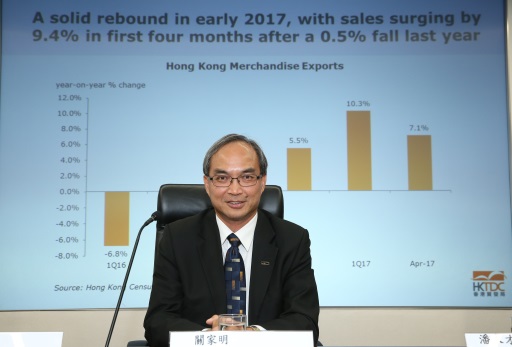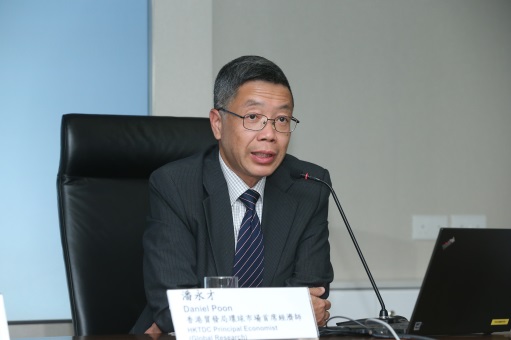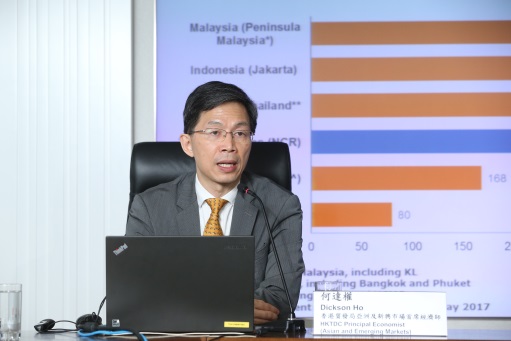HKTDC Research also Explores Philippines as Manufacturing Base
20 June 2017 – The HKTDC Export Index, for the second quarter of 2017 (2Q17), has climbed to a 16-quarter high of 50.1 and up from the 47.1 recorded in the first quarter of the year, the Hong Kong Trade Development Council (HKTDC) announced today. The results are the first since the second quarter of 2013 to surpass the 50 mark, reflecting positive sentiment among local exporters. HKTDC Research also raised its 2017 Hong Kong export growth forecast to five per cent from a flat projection issued last December.

“Overall, exporters have turned cautiously optimistic with regard to their likely export performance over the short term,” HKTDC Director of Research Nicholas Kwan said at today’s press conference.
“Given an improving global trade environment, Hong Kong’s export performance has been above par thus far. With the expansion in both developed and emerging economies staying generally on course, overall foreign demand should remain sturdy over the medium term, although growth of Hong Kong exports is expected to moderate in the second half of 2017 amid a higher comparison base,” he added.

Nevertheless, Mr Kwan warned of major downside risks, namely an undercurrent of protectionism in the United States, political uncertainties in the European Union and heightened geopolitical tensions.
According to the 2Q17 Export Indices for individual markets, China surpassed the US and Japan as the most promising market as viewed by local traders. The Chinese mainland market figure was 51.9, while the EU was up slightly to 49.6, and numbers for the Japan and the US declined.The HKTDC Export Index monitors the current export performance of Hong Kong traders and gauges their near-term prospects. Readings above and below 50 indicate positive and negative sentiment, respectively.

Continued recovery in mature markets
“Helped by a low comparison base and faster recovery of the global economy, Hong Kong’s export performance has so far been above expectations,” said HKTDC Principal Economist (Global Research) Daniel Poon. Hong Kong exports surged 9.4 per cent year-on-year in the first four months of 2017, reversing a 0.5 per cent fall during the whole of 2016.
“In the developed world, rising confidence and falling joblessness have continued to fuel US growth. Given accommodating policies, improving labour markets and increasing exports, the EU is also witnessing a cyclical economic upturn, while the Japanese economy is growing at a modest pace amid sustained fiscal stimulus and steady exports,” Mr Poon said.

In the first four months of this year, Hong Kong exports to the US rose 1.3 per cent, those to the EU were up three per cent, and those to Japan increased 5.3 per cent.
Emerging markets remain promising
While Hong Kong exporters are advised to intensify their sales efforts to capitalise on growing opportunities in the developed world, they should not overlook emerging economies, which are expected to continue to do well over the medium term, he said.
“A projected stabilisation of oil and commodity prices should continue to augur well for the economies dependent on natural resources,” remarked Mr Poon. He added that an improved appetite for consumption in developed nations will further boost export-oriented emerging economies at large.
“Developing Asia continues to be the most dynamic region,” said Mr Poon, noting that although China is experiencing slower growth in the midst of economic restructuring , its pace of expansion is still relatively enviable. In the first four months of 2017, Hong Kong exports to the mainland and ASEAN grew 10.3 per cent and 8.6 per cent respectively.
Bright spots
With cautiously optimistic prospects for overall exports, Mr Poon expected a brighter outlook for several industries:
- Electronics: The sector will remain the main growth driver. Augmented reality/virtual reality (AR/VR) technologies, which are closely related to audio-visual applications, are popular. Wearable electronics are expected to enjoy massive growth, while smart home items have good potential.
- Clothing: An improving global trade environment should stimulate sales, but prospects will be clouded by continued competition from neighbouring countries such as Vietnam, Cambodia, Myanmar and Bangladesh.
- Toys: There are decent sales prospects on the back of sustained interest in licensed toys related to blockbuster movies, strong spending on educational toys, growing interest in toys marketed to adults, and the rising popularity of AR/VR applications for traditional toys.
- Timepieces: A more stable external environment will likely lend support to exports. Smart watches, especially hybrid versions with analogue displays that look like their traditional counterparts, will probably become the new growth medium.
- Jewellery: Demand for high-end items will still be capped by diehard consumer conservatism, but demand will be increasingly robust for more affordable items that feature good design, quality and craftsmanship.
Philippines as an option for manufacturing relocation
For manufacturers seeking alternative production bases to relocate or diversify production in view of soaring costs in the mainland, the Philippines is an alternative, according to an HKTDC Research study highlighted today. Dickson Ho, HKTDC Principal Economist (Asian and Emerging Markets), said that the skilled and trainable workforce and burgeoning retail market in the Philippines offer opportunities.
“The Philippines as a manufacturing base enjoys a distinct edge compared with other relocation hotspots in Southeast Asia with its English-speaking workers, who are both skilled and trainable,” Mr Ho said. “This presents an attractive option to foreign investors confronted with the challenge of labour management and training in alternative production bases.”
The Philippines registered strong economic growth of 6.8 per cent in 2016, driven by robust manufacturing and business processing services, amid strong investment and consumption buttressed by hefty overseas remittances. “Fast income growth and a surge in purchasing power have combined to transform this archipelago state of more than 100 million people into a burgeoning modern consumer market. Foreign manufacturers can find local sales opportunities while also serving the export market,” added Mr Ho.
During a recent trip to Manila, HKTDC Research found that businesses were optimistic about the country’s future development. “They were generally supportive of the government’s economic policy and believed President Rodrigo Duterte’s strong government could better tackle the long-standing problems of red tape and bureaucracy in the Philippines,” reported Mr Ho. “Besides, infrastructure is showing encouraging signs of improvement in areas within and near Metro Manila,” he said.
More than 70 per cent of Hong Kong’s imports from the Philippines in 2016 were re-exported to the mainland, indicating Hong Kong’s important role in Philippine-China trade.
